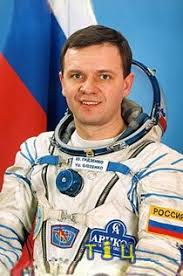Yuri Gidzenko
Russian - (RFSA)
Retired
Date of Birth: March 26, 1962
Age: 63
Yuri Pavlovich Gidzenko (Russian: Гидзенко, Юрий Павлович; born March 26, 1962) is a Russian cosmonaut. He was a test cosmonaut of the Yuri Gagarin Cosmonaut Training Center (TsPK). Gidzenko has flown into space three times and has lived on board the Mir and International Space Stations. He has also conducted two career spacewalks. Although he retired on July 15, 2001, he continued his employment by a special contract until Soyuz TM-34 concluded.
Soyuz-U2 | Soyuz TM-22
Soviet Space Program | RussiaBaikonur Cosmodrome, Republic of Kazakhstan
Sept. 3, 1995, 9 a.m.
Status: Success
Mission:
Soyuz TM-22 was the 23rd mission and the 20th long-duration expedition to Mir space station. It was also a part of the US/Russian Shuttle-Mir Program. The mission began on September 3, 1995, 09:00:23 UTC, launching Commander Yuri Gidzenko, Flight Engineer Sergei Avdeyev and Research Cosmonaut Thomas Reiter into orbit. They docked with Mir two days later. During their stay there, cosmonauts performed several EVAs and various scientific experiments. Station crew was visited by several Progress resupply spacecrafts, STS-74, and welcomed aboard Soyuz TM-23 with the next expedition crew. The mission concluded with a safe landing back on Earth on February 29, 1996, 10:42:08 UTC.
Low Earth OrbitSoyuz-U | Soyuz TM-31
Russian Federal Space Agency (ROSCOSMOS) | RussiaBaikonur Cosmodrome, Republic of Kazakhstan
Oct. 31, 2000, 7:52 a.m.
Status: Success
Mission:
Soyuz TM-31 began Expedition 1 by carrying 3 cosmonauts and astronauts to the International Space Station. Russian Commander, cosmonaut Yuri Gidzenko alongside Flight Engineer, Sergei Krikalev and Flight Engineer/Spaceflight Participant William Shepherd launched aboard the Soyuz spacecraft on October 31, 2000, 07:52:47 UTC. They docked with the station two days later. During their stay there, crew performed first maintenance and repair works, carried out first experiments and conducted several EVAs. They were also visited by several Progress resupply spacecrafts and STS-97 and STS-98 crews, and welcomed aboart STS-102 with the next expedition crew. Expedition 1 returned with STS-102, landing safely back on Earth on 21 March 2001, 07:33:06 UTC.
Low Earth OrbitSpace Shuttle Discovery / OV-103 | STS-102
National Aeronautics and Space Administration | United States of AmericaKennedy Space Center, FL, USA
March 8, 2001, 11:42 a.m.
Status: Success
Mission:
STS-102 was a Space Shuttle mission to the International Space Station (ISS) flown by Space Shuttle Discovery and launched from Kennedy Space Center, Florida. STS-102 flew in March 2001; its primary objectives were resupplying the ISS and rotating the Expedition 1 and Expedition 2 crews.
Low Earth OrbitSoyuz U | Soyuz TM-33
Russian Federal Space Agency (ROSCOSMOS) | RussiaBaikonur Cosmodrome, Republic of Kazakhstan
Oct. 21, 2001, 8:59 a.m.
Status: Success
Mission:
Soyuz TM-33 was a visiting mission to ISS, which carried 3 cosmonauts and astronauts. Russian Commander, cosmonaut Viktor Afanasyev alongside Flight Engineer, ESA astronaut Claudie Haigneré and Flight Engineer/Spaceflight Participant, Konstantin Kozeyev launched aboard the Soyuz spacecraft on October 21, 2001, 08:59:35 UTC. They docked with the station two days later. During their stay there, crew assisted Expedition 3 members in station work. Soyuz TM-33 crew returned aboard Soyuz TM-32, landing safely back on Earth on October 31, 2001, 05:00:00 UTC.
Low Earth OrbitSoyuz-U | Soyuz TM-34
Russian Federal Space Agency (ROSCOSMOS) | RussiaBaikonur Cosmodrome, Republic of Kazakhstan
April 25, 2002, 6:26 a.m.
Status: Success
Mission:
Soyuz TM-34 was a visiting mission to ISS, which carried 3 cosmonauts and astronauts. Russian Commander, cosmonaut Yuri Gidzenko alongside Flight Engineer, ESA astronaut Roberto Vittori and Flight Engineer/Spaceflight Participant Mark Shuttleworth launched aboard the Soyuz spacecraft on April 25, 2002, 06:26:35 UTC. They docked with the station two days later. During their stay there, crew assisted Expedition 4 members in station work. Soyuz TM-34 crew returned aboard Soyuz TM-33, landing safely back on Earth on May 5, 2002, 03:51:53 UTC.
Low Earth OrbitThe Roscosmos State Corporation for Space Activities, commonly known as Roscosmos, is the governmental body responsible for the space science program of the Russian Federation and general aerospace research. Soyuz has many launch locations the Russian sites are Baikonur, Plesetsk and Vostochny however Ariane also purchases the vehicle and launches it from French Guiana.
Long March 3B/E
Fengyun-4C
Launch Complex 2 (LC-2) - Xichang Satellite Launch Center, People's Republic of ChinaChina's geostationary meteorological satellite program FY-4 (Feng Yun 4) is the second generation of chinese geostationary meteorological satellites.
Long March 8A
SatNet LEO Group 17
Commercial LC-1 - Wenchang Space Launch Site, People's Republic of ChinaA batch of 9 Low Earth Orbit communication satellites for the Chinese state owned SatNet constellation operated by the China Satellite Network Group.…
Soyuz 2.1a
Obzor-R No.1
43/4 (43R) - Plesetsk Cosmodrome, Russian FederationNote: Assignment of payloads to this launch is uncertain. The Russian Obzor-R satellite is a planned X-band radar earth observation satellite desi…
LVM-3 (GSLV Mk III)
BlueBird Block 2 #1
Satish Dhawan Space Centre Second Launch Pad - Satish Dhawan Space Centre, IndiaAST SpaceMobile’s Block 2 BlueBird satellites are designed to deliver up to 10 times the bandwidth capacity of the BlueBird Block 1 satellites, requi…
Long March 12A
Demo Flight
Long March 12A Pad - Jiuquan Satellite Launch Center, People's Republic of ChinaFirst test launch of CASC/SAST’s Long March 12A rocket, with a dummy payload. The rocket’s 1st stage attempted to land on a landing pad about 300 km …





